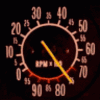It just happens that I'm building a 173 and fitting a blue head, i don't care if you use the info, I have been a heavy vehicle mechanic for 35 year and teaching in TAFE for 20 plus years, so I enjoy sharing information and learning, must admit I know stuff all about holden 6 's
I don't think you want a large chamber blue/black head on a 173. This is how you make a low comp 173!
Unless of course you are boring it +0.065 or +0.125" to make a 179 or 186.
Edited by yel327, 26 December 2013 - 07:37 PM.















